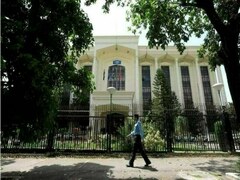HOUSTON: Oil prices surged about 3% on Wednesday, after US crude stocks fell more than expected, adding to worries of supply tightness amid OPEC+ production cuts. Brent crude futures breached $97 a barrel, and was trading up $2.55 to $96.51 a barrel by 11:40 a.m. ET (1540 GMT).
US West Texas Intermediate crude futures (WTI) climbed $3.16 to $93.54. Both benchmarks touched their highest in intraday trading for this year.
US crude stocks fell by 2.2 million barrels last week to 416.3 million barrels, government data showed, compared with analysts’ expectations in a Reuters poll for a 320,000-barrel drop.
Crude stocks at the key Cushing, Oklahoma, storage hub and the delivery point for US crude futures, fell by 943,000 barrels in the week to just under 22 million barrels, the lowest since July 2022, data showed.
“The big news was the storage in Cushing. And that’s causing the whole complex to rally. The biggest concern for traders is Cushing getting near multi month, operational lows.
That’s a bullish force for crude prices,“ said Dennis Kissler, senior vice president of trading at BOK Financial.
“The market is overbought and a correction is definitely needed,” he cautioned. Stockpiles at Cushing have been falling closer to historic low levels due to strong refining and export demand, prompting concerns about the quality of the remaining oil at the hub and the potential to fall below minimum operating levels.
The drawdown in US crude stocks come as Saudi Arabia and Russia - as part of the Organization of the Petroleum Exporting Countries and allies, known together as OPEC+ - have extended voluntary production cuts of 1.3 million barrels a day to the end of the year, worrying markets about supply tightness heading into winter.
“Until a decision to raise production is made, the global energy market will remain tight,” Ole Hansen, Head of Commodity Strategy at Saxo Bank, said.
The lack of spare supply was reflected at the front end of the pricing curve, he said, as the premium for barrels for near-term delivery of WTI has reached almost $2 a barrel compared with those for next month.
WTI’s discount to Brent also hit its narrowest since late April.
Potentially adding to the supply tightness, Russian President Vladimir Putin ordered his government to make sure retail fuel prices stabilise after a jump caused by an increase in exports.
In response, his deputy prime minister said there are proposals to restrict grey fuel export, or the purchase of oil products for domestic use that are exported instead.
The government last week imposed a temporary ban on gasoline and diesel exports to most countries to stabilise the domestic market, though it later softened restrictions.
The impact of tight global supplies could be mitigated if interest rates curb demand.
In a hawkish signal in the US, Minneapolis Federal Reserve Bank President Neel Kashkari said it was not clear whether the central bank has finished raising rates.
Higher interest rates increase borrowing costs, which could slow economic growth and reduce oil demand.
























Comments
Comments are closed.